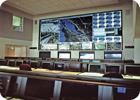Optimizing the Operations Center

Operations centers are the focal point in times of crisis. Pictured here is the California Department of Transportation’s operations center.
Whether your job is to protect the local streets, your country or the company’s assets – the operations center is the central focal point in times of crisis. In the post-9/11 world, the stars have aligned to develop and harness new technologies to provide additional data for a more effective emergency response.
DATA OVERLOAD
As the operations center increases in complexity, the technology intended to make your job easier could make things more confusing at the most critical times, when seconds matter most.When operations centers were conceived, the theory was that if there was a call from the location where an incident was happening, an officer could quickly deploy resources to that location. Call boxes, radios and hard-wired telephone lines provided a pretty effective network of communications for emergency response.
More recently the dynamic of a cell phone in every citizen’s hand, and other technology developments such as alarms, license plate readers, analytics like gun shot detectors and facial recognition, GPS equipment vehicles and two way video surveillance intended to provide a more effective response, have at the same time led to information overload.
VIDEO SURVEILLANCE
Billions of dollars are spent annually on video surveillance equipment. Video technology tied into an operations center creates a centralized bird’s eye view of incidents.There are two issues surrounding video surveillance in an operations center environment: coverage and monitoring. Murphy’s Law tells you that what you are most interested in will happen in a location where you don’t have a camera. Studies demonstrate that an operator’s effectiveness diminishes very quickly while monitoring a video screen for more than 20 minutes.
THE OPERATIONS CENTER – CONVERGED
Everywhere in the world of security and surveillance, there is talk of convergence, e.g., collapsing video surveillance networks onto the IP network. Another important convergence is that of various systems into a single, cohesive intelligent system.The new vision is a converged operations center that has many features. One of them is access to data from various systems including video cameras, sensors, access control, RFID, GPS and intrusion detection systems. Sophisticated event correlation and tracking across systems is always helpful. State of the art collaboration tools can help prevent or solve security issues. Highly advanced visualization techniques including a large video wall are another ingredient in converged operations. There may be plans to install some emerging technology to make your job easier, but the lack of standards across these systems to enable interoperability may be preventing you from doing so.
Only when you take the various disparate systems and integrate them into a single cohesive system used to manage the situation will you have an operations center operating at maximum efficiency.
SIDEBAR: Roadmap to Integration of a Converged Operations Center
Map out your operational goals- When evaluating how to make your vision a reality – you must first map out what you want to accomplish from a day-to-day operations standpoint.
- Determine what existing systems are still relevant.
- Once you have outlined your goals, each installed system should be evaluated to determine if it is still relevant to enable your vision.
- Create a phased implementation plan.
- Due to the complexity or budgets, it is not always practical to take the “big bang” approach to deploying a system. So once you know where you want to go you’ll want to figure out the appropriate steps along the way.
- Have a plan that has the flexibility to be deployed in modules.
Vendor Selection
- Determine what vendors have a shared vision and product roadmap that accommodates your long-term goals. Understanding the roadmap and the refresh plan is critical. Do not accept forklift upgrades – look for companies that provide a seamless migration moving forward.
- Implement the first phase and measure results.
- Once you have the roadmap and have implemented the first phase of the plan, it is extremely important to measure the results.
- Refine plan and implement next phase.
- Once you have measured the results of the first phase – it’s time to determine if your roadmap is still relevant.
Looking for a reprint of this article?
From high-res PDFs to custom plaques, order your copy today!


